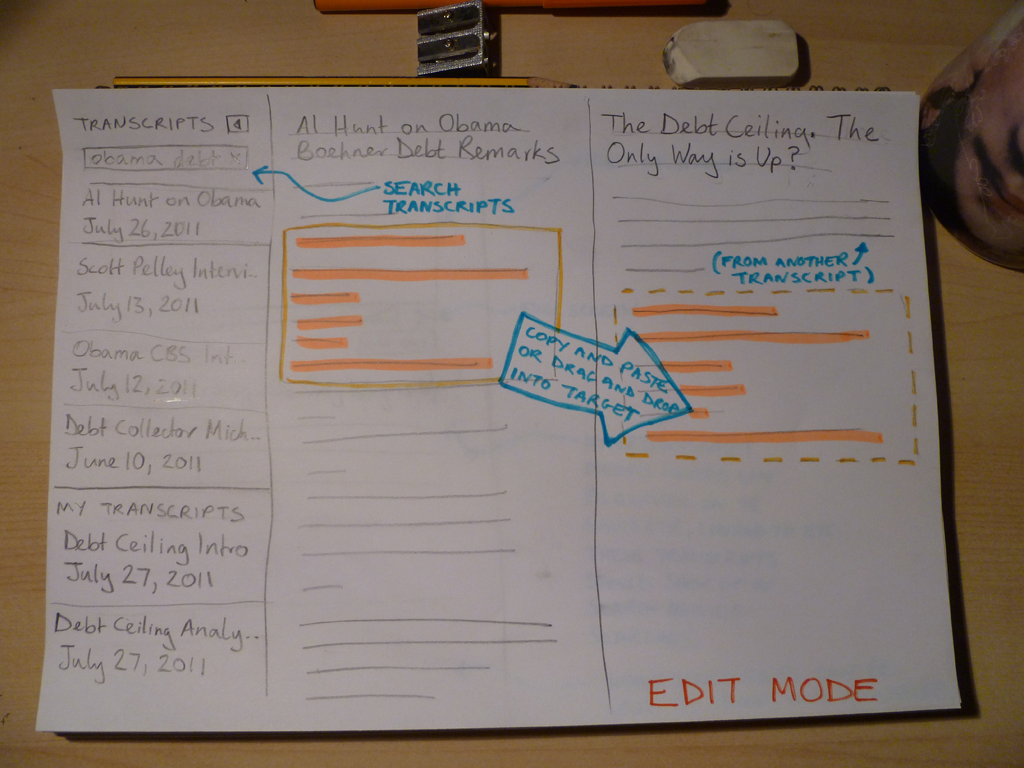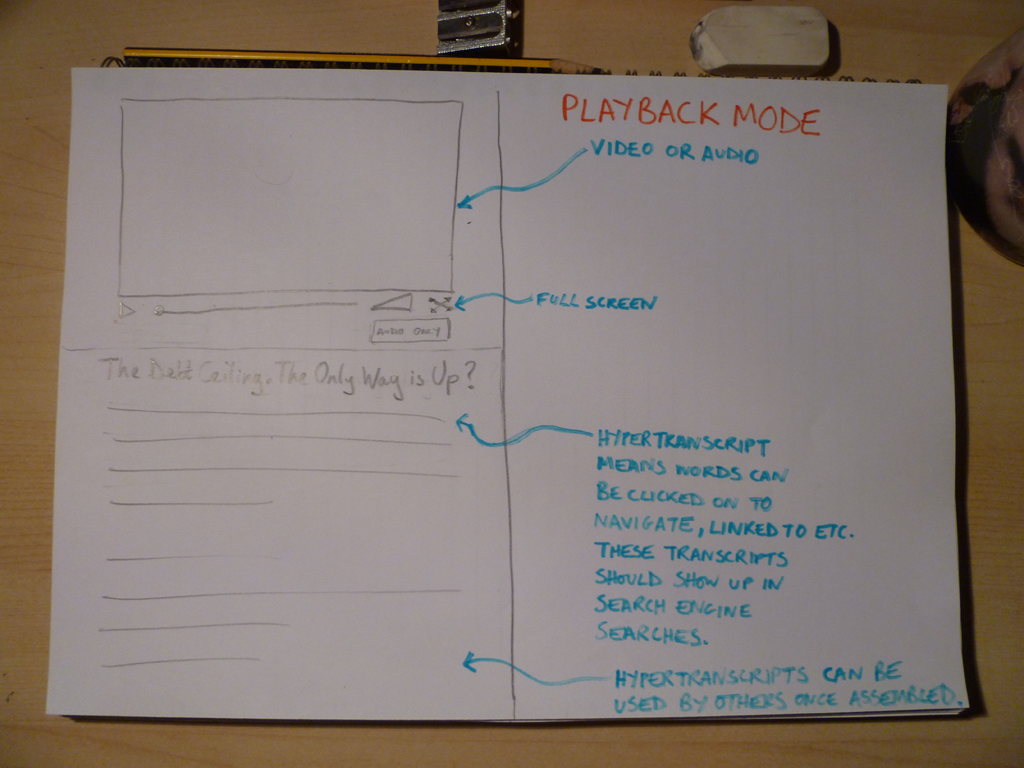simplicity
Introducing the Hyperaudio Pad (working title)
Last week as part of the Mozilla News Lab, I took part in webinars with Shazna Nessa – Director of Interactive at the Associated Press in New York, Mohamed Nanabhay – an internet entrepreneur and Head of Online at Al Jazeera English and Oliver Reichenstein – CEO of iA (Information Architects, Inc.).
I have a few ideas on how we can create tools to help journalists. I mean journalists in the broadest sense – casual bloggers as well as hacks working for large news organizations. In previous weeks I have been in deep absorption of all the fantastic and varied information coming my way. Last week things started to fall into place. A seed of an idea that I’ve had at the back of my mind for some time pushed its way to the front and started to evolve.
Something that cropped up time and again was that if you are going to create tools for journalists, you should try and make them as easy to use as possible. The idea I hope to run with is a simple tool to allow users to assemble audio or video programs from different sources by using a paradigm that most people are already familiar with. I hope to build on my work something I’ve called hypertranscripts which strongly couple text and the spoken word in a way that is easily navigable and shareable.
The Problem
Editing, compiling and assembling audio or video usually requires fairly complex tools, this is compounded by the fact that it’s very difficult to ascertain the content of the media without actually playing through it.
The Solution?
I propose that we step back and consider other ways of representing this media content. In the case of journalistic pieces, this content usually includes the spoken word which we can represent using text by transcribing it. My idea is to use the text to represent the content and allow that text to be copied, pasted, dragged and dropped from document to document with associated media intact. The documents will take the form of hypertranscripts and this assemblage will all work within the context of my proposed application, going under the working title of the Hyperaudio Pad. (Suggestions welcome!) Note that the pasting of any content into a standard editor will result in hypertranscripted content that could exist largely independently of the application itself.
Some examples of hypertranscripts can be found in a couple of demos I worked on earlier this year:
Danish Radio Demo
Radiolab Demo
As the interface is largely text based I’m taking a great deal of inspiration from the elegance and simplicity of Oliver’s iAWriter. Here are a couple of rough sketches :
Edit Mode
Playback Mode
Working Together
Last week I’m happy to say that I found myself collaborating with other members of the News Lab, namely Julien Dorra and Samuel Huron, both of whom are working on related projects. These guys have some excellent ideas that relate to meta-data and mixed media that tie in with my own and I look forward to working with them in the future. Exciting stuff!
Accessibility, Community and Simplicity
In last week’s Mozilla News Lab we were treated to webinars from Chris Heilmann, John Resig and Jesse James Garrett.
Chris (a Technical Evangelist for Mozilla), took us on a useful whistle-stop tour of HTML5 and friends, technologies that I certainly wish to take advantage of in my final project. I feel that there’s so much potential yet to be tapped, it’s difficult to know where to start, but I’ll definitely be using the new audio and video APIs and looking into offline storage. Chris also touched on accessibility, something that I want to bake into any tool I come up with. To me accessibility is interesting, not just from the perspective of users with disabilities but also because I hope to do is make news (and the tools to create news) more accessible to all people.
John’s talk was fascinating to me as a project coordinator of a JavaScript library, relating directly to the News Lab I found it interesting that many successful projects are a product of both good tools and strong community. The community aspect cannot be underestimated and is perhaps more important than the quality of the tool or service (which can always be improved by the community). I spoke about ‘Community Driven Development’ this year at FOSSCOMM and so is close to my heart, but to hear this confirmed by someone who has experienced success at the very highest level was great. I am now convinced that whatever ever form my final project takes, it will not only be community driven but it will have community built in, which to me means:
- Providing forums and methods of communication and feedback with the initial release
- Building extensibility into the tool so people can add functionality via plugins
- Encouragement of collaboration – make it easy for people to get involved
- Making sure that the documentation is comprehensive and clear (and can be contributed to)
- Fanatical support and encouragement
I also attended the ‘extra’ webinar given by Jesse James. In some ways this was the most useful to me as it focussed on designing the user experience or UX, something I’m keen to learn more about and who better to tell me than the author of The Elements of User Experience. It was fascinating to take a peak at how UX experts like Jesse approached the subject of design. I sat there transfixed as he broke down the process and discussed ideas such as psychology, emotion and how the user feels and their relationship with a given product or tool. Jesse spoke about the personality of a product and how users relate to tools as they would another person, using similar parts of the brain as they do when relating to people.
I really want the tool I create to be as simple as possible to use, so my question to Jesse was :
“Is it possible to make a product so simple that it doesn’t need a personality, or needs less? Or is the simplicity its personality?”
The answer : “Simplicity is a personality.”
Great. Hopefully I’m on the right track then.
Previous Posts
- The Hyperaudio Pad – Next Steps and Media Literacy
- Breaking Out – The Making Of
- Breaking Out – Web Audio and Perceptive Media
- Altrepreneurial vs Entrepreneurial and Why I am going to Work with Al Jazeera
- HTML5 Audio APIs – How Low can we Go?
- Hyperaudio at the Mozilla Festival
- The Hyperaudio Pad – a Software Product Proposal
- Introducing the Hyperaudio Pad (working title)
- Accessibility, Community and Simplicity
- Build First, Ask Questions Later
- Further Experimentation with Hyper Audio
- Hyper Audio – A New Way to Interact
- P2P Web Apps – Brace yourselves, everything is about to change
- A few HTML5 questions that need answering
- Drumbeat Demo – HTML5 Audio Text Sync
Tag Cloud
-
Add new tag
AJAX
apache
Audio
band
buffered
Canvas
CDN
chrome
community
custom tags
firefox
gig
HTC
HTML5
Hyper Audio
internet explorer
java
javascript
journalism
jPlayer
jQuery
jscript
LABjs
leopard
media
Mozilla
MVP
opera
opera mini
osx
P2P
Popcorn.js
poster
prototyping
rewrite
safari
Scaling
simplicity
SoundCloud
timers
tomcat
video
Web Apps
web design

